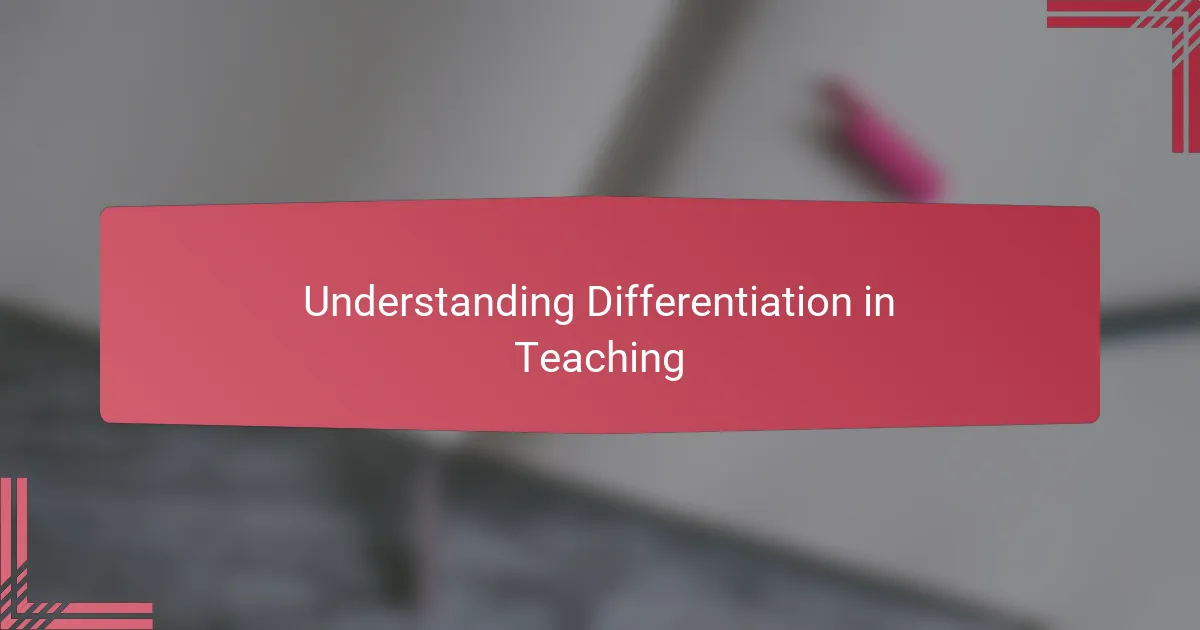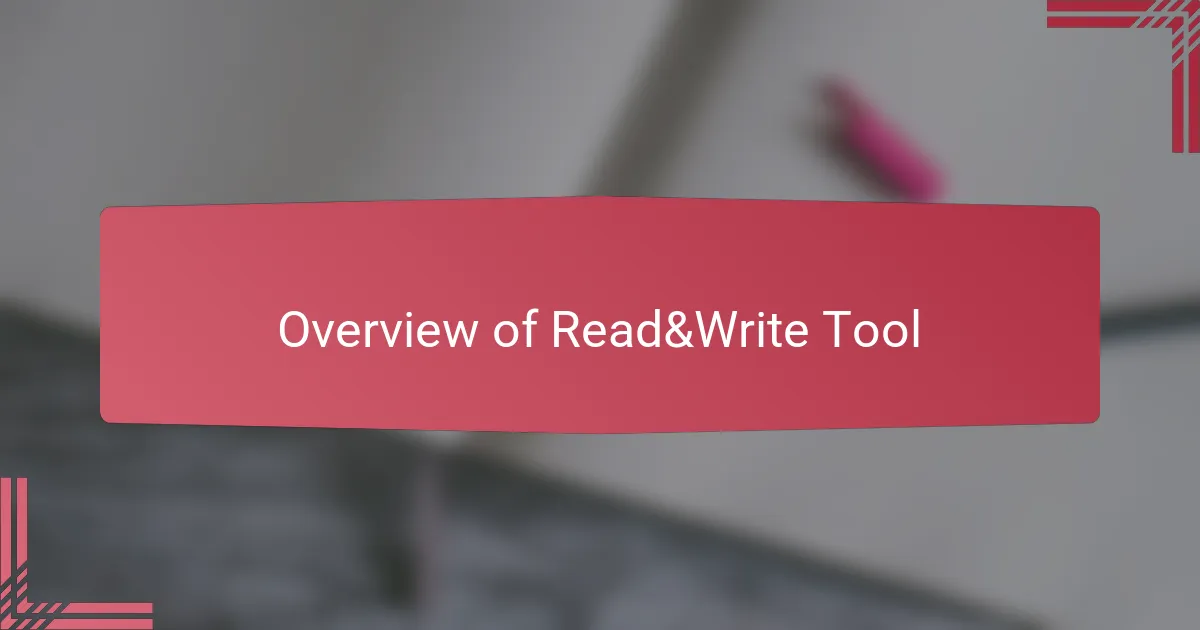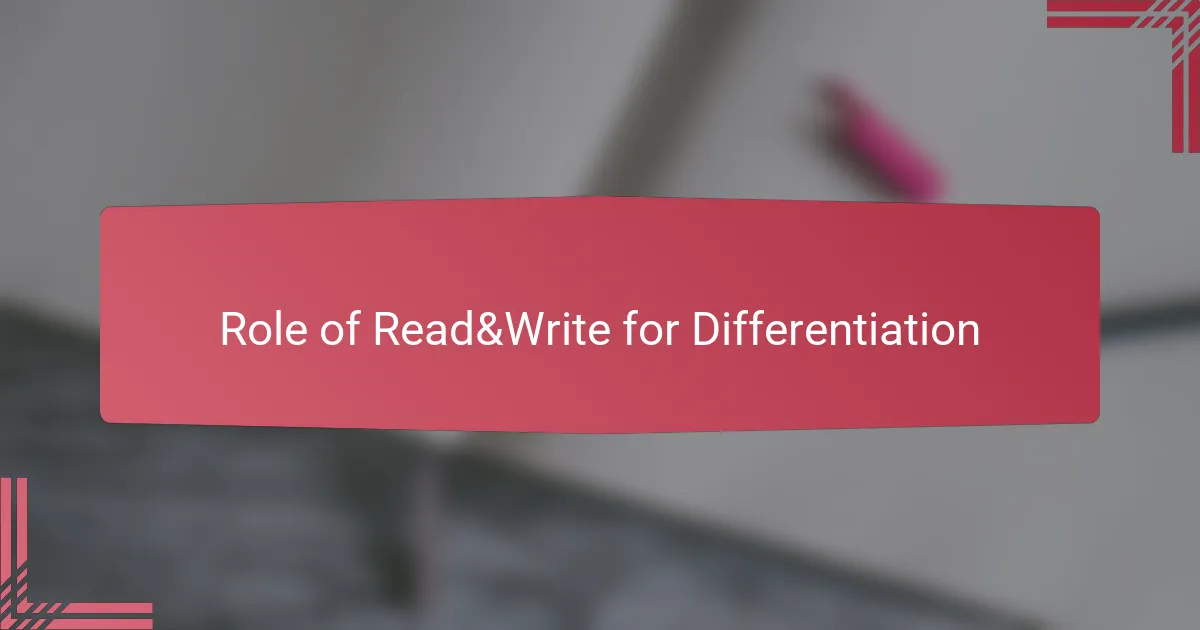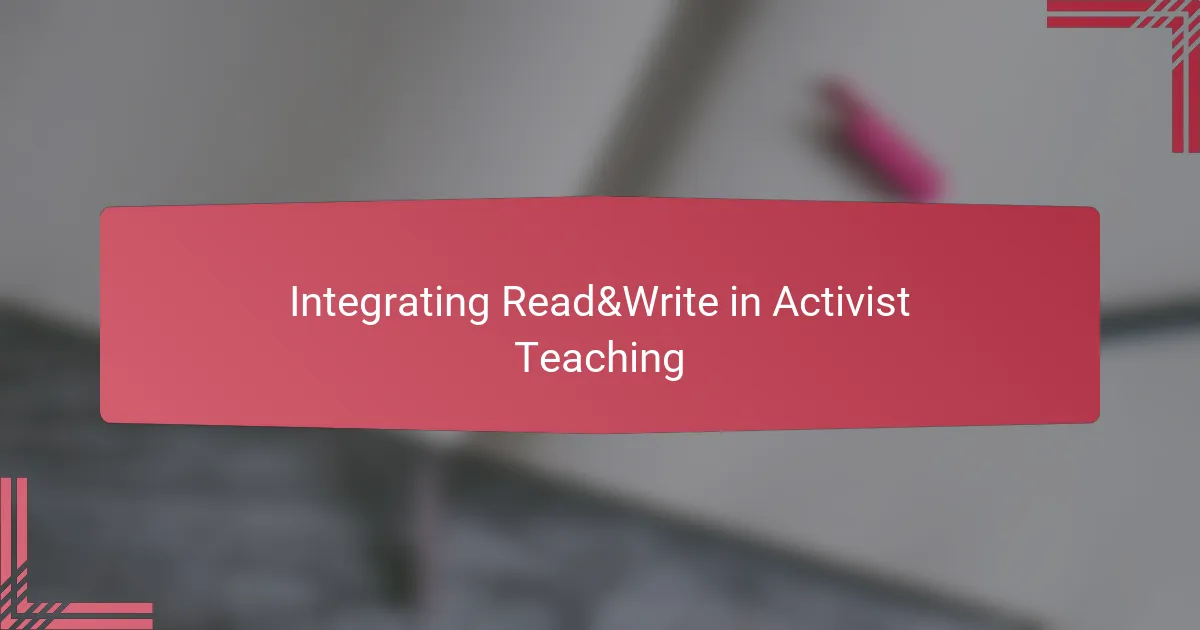Key takeaways
- Differentiation in teaching is essential for addressing diverse student learning styles, ensuring engagement and understanding for all learners.
- The Read&Write tool enhances differentiation by providing flexible supports, such as text-to-speech and vocabulary assistance, promoting student independence and self-expression.
- Integrating technology like Read&Write fosters critical thinking and enables deeper discussions on topics, aligning with equitable teaching practices.
- While challenges exist, including initial learning curves and technical issues, these experiences can lead to greater resilience and adaptability in both teachers and students.

Understanding Differentiation in Teaching
Differentiation in teaching, to me, has always been about recognizing that no two students learn the same way. Early in my career, I realized that a one-size-fits-all lesson plan ignored the diverse strengths and needs in my classroom. Have you ever noticed how some students grasp concepts quickly when they hear them, while others need to see or do something to truly understand?
This realization made me rethink how I approached lessons. Differentiation means tailoring instruction to match each learner’s readiness, interests, and learning profile. It’s not just about academic levels; it’s about honoring the whole student and making space for genuine engagement.
Sometimes, differentiation can feel overwhelming—how do you manage so many variations simultaneously? I found that starting small, like modifying a single activity or providing a choice in how students express their learning, made the task manageable and far more rewarding. Have you tried this approach before? It’s a game changer when you see the spark of connection in a student’s eyes.

Overview of Read&Write Tool
When I first discovered the Read&Write tool, it felt like finding a secret weapon for differentiation. This software offers a variety of supports—like text-to-speech and word prediction—that really address the unique challenges my students face. Have you ever struggled to keep every learner engaged even when they have different reading levels? Read&Write steps in to fill those gaps.
What struck me most was how accessible and easy to use it is, both for me and my students. Instead of complicated setups, it seamlessly integrates with the platforms we already use, making it less of a chore and more of a natural extension of our lessons. This meant less time troubleshooting and more time focusing on teaching.
Another feature that resonated deeply with me was the tool’s ability to support independence. I remember seeing a shy student confidently use the speech-to-text function to express ideas they struggled to write down before. Moments like that reminded me why tools like Read&Write are essential—they don’t just aid learning but empower self-expression.

Role of Read&Write for Differentiation
Read&Write plays a pivotal role in differentiation by offering flexible supports that meet students exactly where they are. I’ve seen firsthand how its text-to-speech feature helps auditory learners process information more deeply, while visual learners benefit from highlighting tools that break down complex texts. Have you noticed how these options let students take control of their learning, making the classroom feel more inclusive and responsive?
What I appreciate most is how Read&Write allows me to tailor tasks without reinventing the wheel each time. Instead of preparing multiple versions of a worksheet, I can rely on the tool to adapt content on the spot, saving valuable time and energy. It’s like having a co-teacher who’s attuned to every student’s unique needs—something every activist teacher dreams of.
Sometimes, I reflect on the moments when a student’s confidence soared because Read&Write made a lesson accessible in a new way. These sparks of independence remind me that differentiation isn’t just about strategies; it’s about honoring voices that might otherwise stay silent. Isn’t that, after all, what meaningful teaching is about?

Integrating Read&Write in Activist Teaching
Integrating Read&Write into activist teaching felt natural because it aligns with my commitment to equity in the classroom. When I introduced the tool, students who usually held back suddenly had the means to participate more fully, challenging me to rethink who really had access to learning. Have you ever witnessed a quiet student light up just because they finally had the tools to share their ideas without barriers?
What I find powerful is how Read&Write supports critical thinking, not just comprehension. For example, when students used the research and vocabulary features, I noticed deeper discussions emerge around social justice topics. It’s as if the tool broke down not only reading hurdles but also opened doors for richer activism-focused conversations.
At times, I wonder how teaching would look without such assistive technology. The ability to differentiate seamlessly means I can focus more on facilitating dialogue and reflection rather than constantly adapting materials. Doesn’t that shift in focus make the teaching experience more meaningful—for me and my students alike?

Practical Strategies Using Read&Write
One practical strategy I rely on is encouraging students to use the text-to-speech feature during independent reading. I’ve noticed that when a student listens to a passage aloud, it often clicks in a way silent reading doesn’t achieve. Have you ever tried this? It transforms reading from a solo struggle into a shared experience between the student and the text.
Another go-to tactic involves leveraging the vocabulary support tools. In lessons around complex social issues, I’ve watched students pause less and dive deeper because they can easily check meanings without interrupting their flow. This small adjustment helps keep their critical thinking muscles flexing rather than shutting down at unfamiliar words.
Finally, I invite students to choose how they respond—typing with speech-to-text, recording audio responses, or highlighting key ideas. Giving them that voice not only boosts engagement but also honors their individual learning styles. Isn’t it incredible how a few practical tweaks with Read&Write can make differentiation feel manageable and even empowering?

Challenges Faced and Solutions
One challenge I faced was the initial learning curve with Read&Write—not just for me, but for my students as well. It took patience and a bit of trial and error to get everyone comfortable, especially those who were hesitant to try new technology. Have you ever watched a student’s frustration melt away once they finally clicked with a tool? Watching that transformation made all the effort worth it.
Another hurdle was balancing the use of Read&Write without letting it overshadow other important teaching approaches. Sometimes, I worried that relying too much on technology might reduce human interaction or creativity. But then I realized that Read&Write is most powerful when it complements, not replaces, my role—giving me space to engage more deeply with students instead of just managing logistics.
Finally, I had to address technical issues like software updates and compatibility glitches that interrupted lessons unexpectedly. It was frustrating at times, no doubt. What helped was preparing backup plans and involving students in troubleshooting, turning those moments into informal lessons about resilience and adaptability. In the end, these challenges deepened my appreciation for how technology and human effort must work hand in hand.

Reflections on Differentiating with Read&Write
Reflecting on my experience differentiating with Read&Write, I realize how much the tool has shifted my perspective on what’s possible in the classroom. It’s one thing to plan diverse activities, but seeing a student independently navigate a challenging text using the software felt like witnessing a breakthrough moment—a spark of confidence lighting up their learning journey. Have you ever had a moment where a small adjustment made a huge difference? For me, Read&Write was that game changer.
I also noticed that differentiation with Read&Write isn’t just about accessibility; it’s about redefining student agency. Watching learners choose their own paths—whether by listening to text, highlighting key ideas, or using speech-to-text—reminded me that empowerment comes from giving ownership. It pushed me to rethink how I design lessons, focusing less on rigid structures and more on fostering autonomy. Isn’t that what truly inclusive teaching should look like?
At times, I found myself reconsidering my role in the classroom as a facilitator rather than just a provider of content. With Read&Write supporting multiple learning styles simultaneously, I could step back and engage more deeply in meaningful conversations, instead of constantly troubleshooting or adapting materials. This shift felt freeing and made me appreciate how thoughtful use of technology can bring us closer to the heart of teaching—which is connecting with students on their terms.